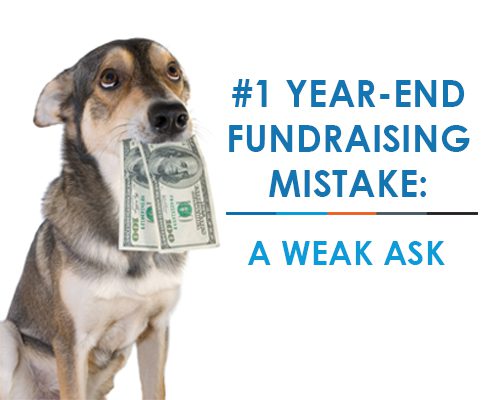#1 Year-End Fundraising Mistake: A Weak Ask
 Are you making year-end fundraising mistakes?
Are you making year-end fundraising mistakes?
Too many organizations are not asking often enough. And when they do ask, they do it poorly.
This is happening with far too many nonprofits. Especially smaller organizations – and some large ones too!
These poor organizations are simply leaving money on the table.
Far too many organizations are sending out too few appeals, with timid letters that make weak asks.
I see year-end “campaigns” that only send one paper letter and perhaps 2-3 emails.
Here’s an example:
Receive expert advice. Direct to your inbox. Subscribe
I was chatting with one of INSIDERS yesterday – a foster care agency.
She shared that they were sending out stand-alone appeal letters in September, December, March and June.
She was making these same year-end fundraising mistakes! And she was wondering why she was not getting much of a response.
Expand Your Appeal into a Mini-Campaign
A single stand-alone appeal letter is a weak ask. It may have only a 15% response rate, according to direct mail guru Mal Warwick.
Here’s why: If you drop only one letter to your donor, it won’t make a very large impact on her brain.
It takes repeated messages to your donor before your heartfelt missives finally “land” on her busy brain.
She may totally LOVE you and be completely devoted to your cause. But she may simply miss your letter because she’s so busy.
Find out how we can help you achieve your fundraising goals with world-class consulting and custom training.
So you must, repeat must, make your appeal crystal clear.
And that means sending your request more than once.
Create a mini-campaign with several appeal letters and emails all tied together.
Too many organizations need to wake up, get over this fear of asking, and create true “cheerfully aggressive” fundraising campaigns.
That’s how you avoid making deadly year-end fundraising mistakes.
Mini-Campaigns are Smart Fundraising
The first letter can be a warm up, outlining the challenge you are seeking to address.
It lays the groundwork. You can ask in this letter as well.
The second letter can be a very strong ask.
Make your case and share explicitly what you are raising money for and what the impact will be of this new money. Illustrate it with a story.
The third letter can be a simple followup. Followup letters can bring in 14-25% more revenue in your campaign, according to Mail Warwick.
For a great followup letter, do this:
- Make it shorter and briefer than your first appeal.
“This is a quick reminder.
- Repeat the themes, the look, the layout, the images of your first appeal.
- Consistency is key. The letter is merely reinforcing what you’ve already laid out.
- Has a P.S. that asks again, and connects with the impact, as in:
“Please send your gift now to help preserve the lovely woodlands of our state.
- Has a reply envelope and card.
Remember Direct Mail Rule #1: “Make it easy for your donor to give.”
The followup letter sounds like this:
“We haven’t heard from you yet! The kids are all hoping to be able to go to camp next summer – and you can send a lucky kid to camp!. . . .
Or
“We haven’t heard from you yet! Our ballerinas are practicing for next year’s performances, but they need your help to perform on stage. . . .
Or
“We haven’t heard from you yet! The desperately sick people in Africa don’t want to give up hope. Your gift will help them. . . . .
What about asking too often? Doesn’t over-solicitation drive donors away?
Yes this is true. There is a danger in sending too many appeals.
One of the #1 reasons that donors stop giving is because they feel over-solicited. It’s a huge fundraising mistake.
But I’m willing to guess that YOU are NOT over-soliciting. YOU are just nervous about asking, isn’t that it? :)
Here’s what over-soliciting actually is (at least in my book):
— When an organization peppers the donors with frequent appeals. Every 2, 4 or 6 weeks.
— When donors are asked for a gift before they receive acknowledgement and meaningful information about the impact of their gift.
— When donors are asked in a very organization-centered way. Such as,
“We need you! Please send your gift today so that we can do xx, yyy and zz work.
— Sending a generic unrestricted ask.
BOTTOM LINE: Don’t make these fundraising mistakes.
Be sure to turn your mailings into mini-campaigns. Don’t be afraid to ASK!
Don’t forget a terrific followup letter.
And let me know how you do!


